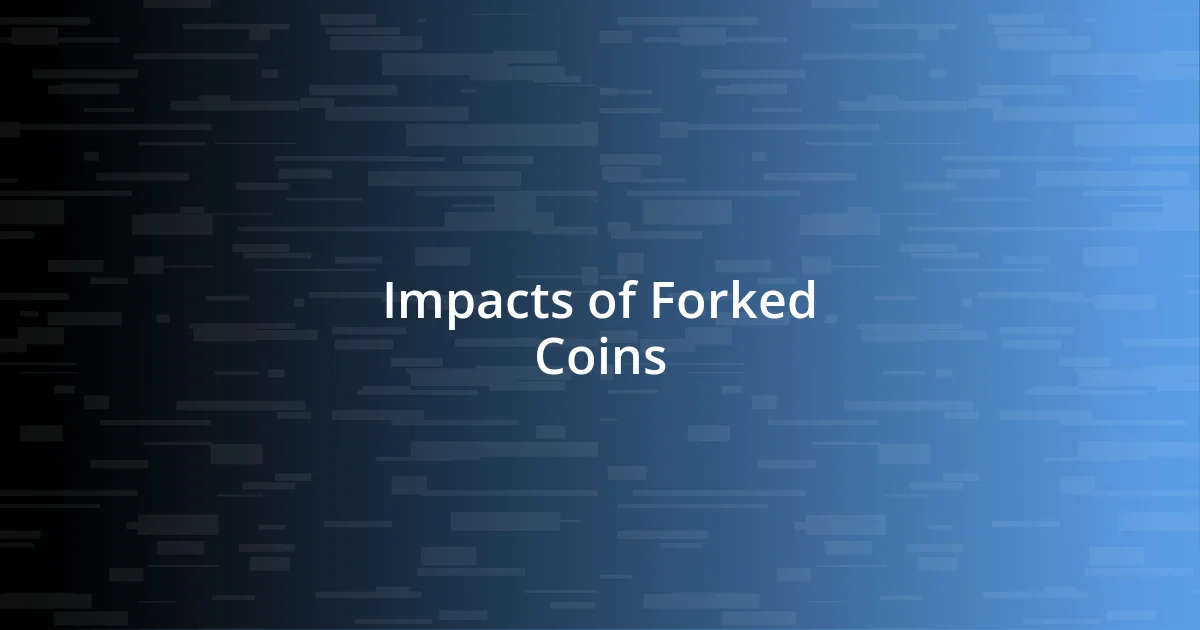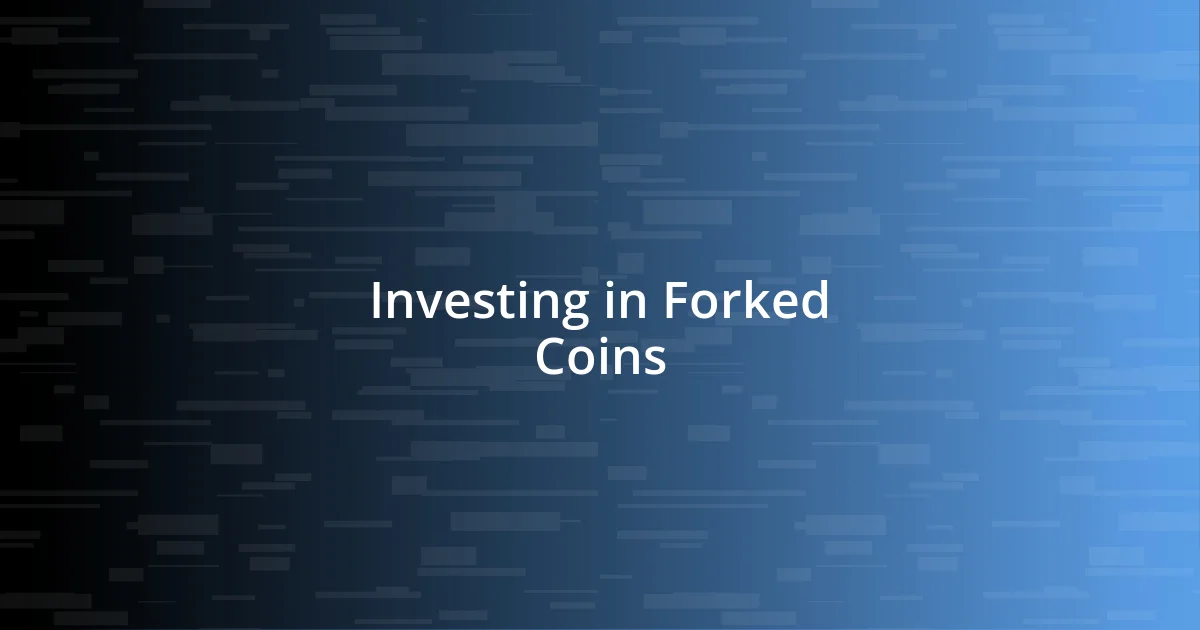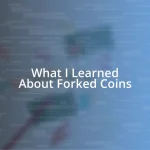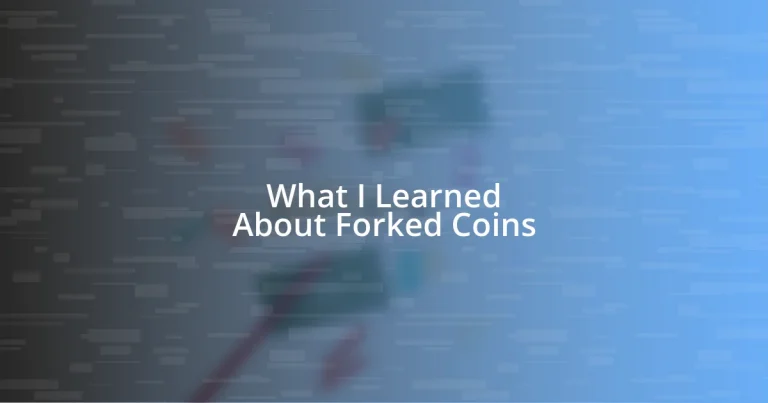Key takeaways:
- Forked coins arise from blockchain changes, creating distinct versions of currencies, as seen with Bitcoin Cash and Ethereum Classic.
- There are two main types of forks: soft forks (backward-compatible) and hard forks (creating new, incompatible coins), each affecting community dynamics and market value differently.
- Future forks will likely emphasize governance models and community engagement, with their success driven by both technology and the narratives surrounding them.

Understanding Forked Coins
Forked coins originate when a blockchain undergoes a change, leading to a split that creates two distinct versions of the currency. I remember when Bitcoin Cash was launched in 2017, and the buzz around it was palpable. It made me ponder, what does it really mean for the future of cryptocurrencies when such splits happen?
In my experience, understanding the implications of forked coins is crucial, especially when it comes to potential investment opportunities. For instance, I found myself examining the reasons behind the fork—whether it was due to disagreements on the protocol or to enhance scalability. Each fork has unique motivations that can influence its value and credibility in the market.
Have you ever tried using a forked coin for transactions? I still recall my first attempt with Ethereum Classic, which was a fascinating experience. It felt like stepping back in time, using a version of Ethereum that diverged from its original path. It’s intriguing how these alternative paths can reflect different philosophies in the crypto community, don’t you think?

Types of Forked Coins
Understanding the types of forked coins reveals a fascinating landscape in the cryptocurrency world. There are generally two main types: soft forks and hard forks. A soft fork is a backward-compatible upgrade, allowing non-upgraded nodes to function without issue, while a hard fork involves a divergence creating two incompatible versions. When I first heard about soft forks, I was intrigued by how they maintain continuity. It felt like a bridge connecting differing perspectives within a single community.
In contrast, hard forks can lead to the creation of entirely new coins, which can sometimes provoke significant debate. A vivid memory surfaces from the day Bitcoin Cash emerged from Bitcoin. The excitement was palpable; many discussed whether to invest in both currencies or stick with the original. I delved into the reasoning behind that hard fork, discovering how community disagreements over scalability drove the split. Such moments in cryptocurrency history have shaped the market as much as the technology itself.
Here’s a simple comparison table to illustrate these fork types:
| Type | Description |
|---|---|
| Soft Fork | Backward-compatible upgrade allowing for continuity and no split. |
| Hard Fork | Creates a new, incompatible version leading to two separate coins. |

Origins of Forked Coins
Forked coins have a rich and varied history that illustrates how dynamic the cryptocurrency ecosystem can be. It all began with Bitcoin’s initial launch in 2009, where its code was open-source. This openness allowed developers to experiment, leading to the first notable fork—Bitcoin XT—just a year later. I vividly recall how that marked the beginning of various ideological divides, each fork representing diverse visions for cryptocurrency’s future.
What truly fascinates me is the myriad of reasons behind each fork, reflecting underlying philosophies within the crypto community. Here’s a concise list of key origins and motivations for forked coins:
- Disagreements on scalability: Different views on how to scale blockchain networks often result in forks. For example, Bitcoin Cash’s emergence stemmed from debates about how to increase transaction throughput.
- Protocol upgrades: Some forks arise as teams seek to improve features or security, pushing updates that might not be universally accepted.
- Philosophical differences: The launch of Ethereum Classic, following a contentious hard fork from Ethereum, highlights contrasting beliefs about governance and community consensus.
- Community reactions: Sometimes, forks happen because of disputes within communities, where factions form around varied visions of a project’s path.
Each fork tells a compelling story, and I often find myself reflecting on the motivations behind them, recognizing that each split is more than just a technical event—it embodies the aspirations and disagreements of its contributors.

Impacts of Forked Coins
When I consider the impacts of forked coins, one significant aspect is how they can stir community dynamics. Just think about when Ethereum split into Ethereum and Ethereum Classic! There was a tension in the air, reflecting deep disagreements over the direction of the project. It’s eye-opening how such divisions not only create new currencies but also reshape relationships within the cryptocurrency community, often leading to the rise of rival factions that champion different visions.
Another impact I’ve observed is the market volatility that forks can introduce. Each time a hard fork occurs, the original coin often experiences price fluctuations. For instance, when Bitcoin Cash was launched, I remember watching Bitcoin’s price drop momentarily while traders scrambled to position themselves. It highlighted how speculation can drive immediate reactions, as each fork creates new opportunities and risks for investors.
Lastly, there’s an undeniable influence on innovation. Forked coins can act as experiments that push boundaries. For instance, the forks that resulted in Litecoin and Bitcoin Gold offered distinct features that aimed to improve upon Bitcoin’s original model. I often find myself reflecting on how these variations can lead to technological advancements, ensuring the entire ecosystem continues to evolve rather than stagnate. Isn’t it fascinating how each fork, intentionally or not, drives the entire discourse of cryptocurrency forward?

Evaluating Forked Coins
Evaluating forked coins requires a blend of technical knowledge and an understanding of community sentiment. When I’m analyzing these coins, I often pause to consider their underlying technology and how it differentiates from the original currency. For instance, when Bitcoin Cash was born, I remember diving into its block size increase. It made me wonder: could this change truly enhance scalability, or would it create other unexpected problems?
Beyond the tech, the motivations of the community involved heavily influence a fork’s success. One lesson I learned through my research is that a strong, engaged community can be a fork’s lifeblood. For example, during the launch of Ethereum Classic, I observed passionate supporters who believed in preserving the original vision. Their unwavering dedication sparked my curiosity about the importance of ethos in driving a forked coin forward. Have you ever felt that sense of loyalty to a project? It really brings home the reality that true value often lies not just in the code, but in the people who back it.
Lastly, market performance is a critical metric in evaluating forked coins. I still vividly recall the whirlwind around the launch of Bitcoin Gold. Watching the immediate price reaction was exhilarating and nerve-wracking all at once; I found myself asking whether this new coin had the potential to carve out its place in a crowded market. In my experience, forks are not merely technical splits, but also thrilling narratives filled with financial intrigue, making them a fascinating area of study in the crypto realm.

Investing in Forked Coins
Investing in forked coins can be a thrilling adventure, but it’s essential to approach it with caution. I remember the buzz when I first invested in a forked coin. The excitement was palpable, but my heart raced as I considered the inherent risks—market volatility, speculative trading, and the uncertainty of how a new currency might perform over time. Have you ever felt that mix of thrill and anxiety? It makes investing feel almost like a rollercoaster ride!
One thing I’ve learned is the importance of timing and news surrounding a fork. When Bitcoin was about to split into Bitcoin Cash, I was glued to my screen, analyzing every update. It struck me how a simple announcement could send prices soaring or plummeting in mere moments. I often wonder, how do some investors seem to predict these shifts? Perhaps it’s a blend of intuition and experience, but being informed certainly gives you an edge.
Finally, diversifying your investments in forked coins is a strategy I’ve come to appreciate. I recall spreading my investment across several forks during the year of high-profile splits. Rather than banking solely on one success, I aimed to capture the varying potential of multiple projects. It was a lesson in balancing hope and pragmatism. Wouldn’t you agree that having a diverse portfolio helps cushion the impact of any single failure? That strategy has provided me with both peace of mind and the opportunity to capitalize on unexpected successes.

Future of Forked Coins
The future of forked coins is both intriguing and unpredictable. I often find myself reflecting on how the rapid evolution of blockchain technology could lead to even more forks. For example, as we witness advancements in privacy features or scalability solutions, I can’t help but wonder: will future forks create entirely new ecosystems, or will they simply serve as alternatives to existing ones?
One trend I suspect we’ll see is a growing emphasis on governance models within forked coins. I’ve observed that projects with strong, decentralized governance often foster a deeper sense of community—something vital for survival in the long run. Just think about how Vitalik Buterin’s approach to Ethereum has encouraged user participation. How might such governance structures empower users and affect the trajectory of future forks? I believe we’re on the cusp of an era where user engagement becomes a deciding factor in a forked coin’s longevity.
As I look ahead, it’s clear that forks won’t only be defined by technology, but also by their narratives. The emotional connections people form with these coins can drive their success. For instance, witnessing a community rally around a fork during challenging times reminds me of the power of shared beliefs. If we consider how invested people have become in projects like Dogecoin, we must ask: is the heart of the future really about the code, or is it about the stories that weave us all together? I’m convinced that the interplay of technology, governance, and community sentiment will shape the future landscape of forked coins in unexpected ways.












